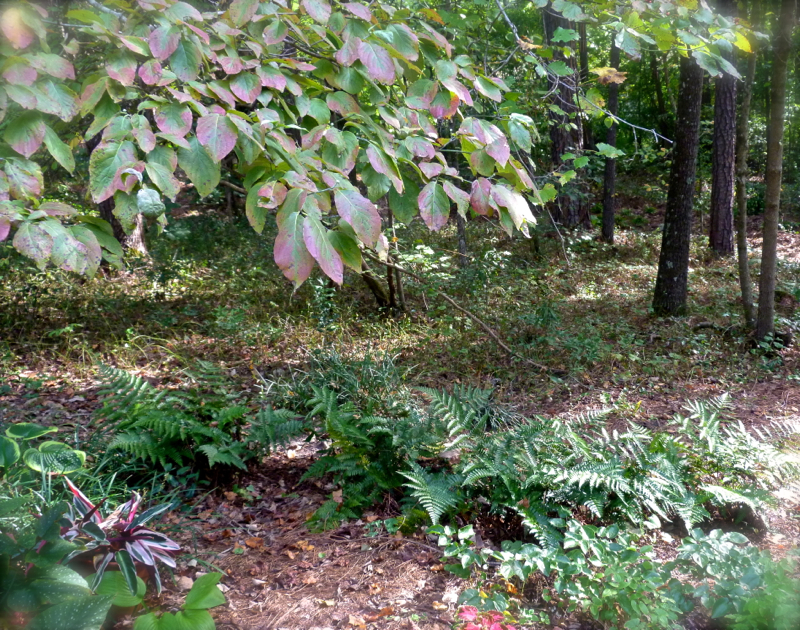Planting a Fern Glade
 Saturday, September 15, 2012 at 8:25PM
Saturday, September 15, 2012 at 8:25PM Once upon a time, I got in trouble with the law for stealing a fern. This happened soon after Lou and I moved to our first house. We were much younger then and very naive. One day we were hiking at a state park when we came upon a fern glade under towering pine trees. Beams of light were streaming across the forest floor, and we stood in awe before a sea of green fronds reaching into the flickering rays. Although not the fern glade I saw so many years ago, this one located at Birmingham Botanical Gardens also has been an inspiration to me.
Although not the fern glade I saw so many years ago, this one located at Birmingham Botanical Gardens also has been an inspiration to me.
I wanted one of those ferns, so Lou dug up a clump for me. Looking back, I can't believe we thought it was OK to do this. (In those days we also used to cut our Christmas trees from public land along the road side, so I guess this seemed to be the same sort of thing to us.)
Back in the car, with the fern resting on my lap, we headed for home. Just before leaving the park, we pulled into the information center to get some brochures, and Lou left me sitting in the car while he went inside. The fern in my lap was huge, and I was happily imagining its new home in my yard when a park ranger knocked on my window.
I smiled at him.
"I hope you didn't get that fern from inside this park," he said grimly.
"Well, yes."
"You know that's a two hundred dollar fine."
"Oh, no, I didn't know that. Here, you can have it back!"
The ranger confiscated the fern and let me go with only a stern lecture. But I have never forgotten the vision of the ferns we saw that day. I think Lou has never forgotten either, because it was his suggestion earlier this year that we plant a fern glade.
I have a few ferns already, including a grouping of Autumn Fern growing in the woodland garden. These are nice, but a swath of ferns like we saw on that long ago morning — that is something to aim for!
These are nice, but a swath of ferns like we saw on that long ago morning — that is something to aim for!
So this week I began. I started with fourteen ferns, and they cover a small area beside a side path in the woodlands. The grouping hardly qualifies as a glade. In fact, the ferns could easily be overlooked as stray weeds! But I know they will grow and hopefully spread, and as time passes we will be clearing more land and adding to their numbers.
These are the four types of ferns I planted:Clockwise from top left: More autumn ferns! These have been dependable in my garden and have survived several droughts; This unnamed fern was given to me by a friend. It has spread prolifically in his garden, and I hope it will do the same in mine; Holly fern has done well in other areas of my garden; Southern wood fern, Dryopteris ludoviciana, is a native that should spread well, also.
Ferns generally are easy care plants if given a good environment. We think of ferns requiring damp, shady conditions, but many will thrive in soil that is relatively dry, as long as they have free draining, loose soil. Ferns have lots of delicate roots which must spread out to prosper, so hard, compacted soil won't do. Filtered light is always best, though some can take more sun than others. Most ferns will not tolerate hot afternoon sun.
Well, as soon as my shovel pushed into the surface of the soil, it bounced right back. I think I decided to plant my fern glade on the site of an old rock quarry! I dug out as many rocks as possible, then added lots of organic soil conditioner rich in humus. I avoided tree roots as much as possible. There was plenty of pine straw and old rotted leaves in the area, and I used this to mulch around each fern as I planted it. I made sure I didn't get dirt in the crowns of the plants. I watered them well and plan to do this regularly until they become well established. Fall tends to be one of our wetter seasons, and in my mild climate the ferns should have time for their roots to establish themselves before the stress of next year's summer.
Large woodland type ferns require little maintenance and may grow happily undisturbed for many years, but if desired, older clumps may be split apart with two forks and replanted. For a neat appearance one may cut away dead or unsightly fronds in the spring. Because they don't produce flowers, ferns don't require much fertilizer. An organic fertilizer such as well rotted manure or compost may be used as a side dressing in the spring. I also like to water with an Epsom salts solution, two tablespoons per gallon of water, once as growth begins in spring and again in June. Epsom salts contain magnesium sulfate, which promotes plant growth and greening of leaves.
I don't know that my fern glade will ever in my lifetime match the idealized one of my memory. But I dream that one day, long after other parts of my garden are gone, someone will come across an unexpected fern glade in the woodlands and stand there for a moment, holding breath in awe.
 Permalink
Permalink 

